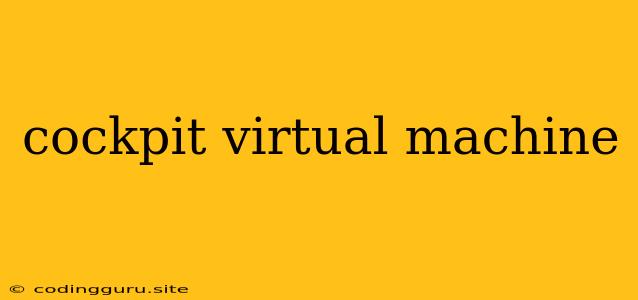Unlocking the Power of Virtual Machines: A Comprehensive Guide to Cockpit
What is Cockpit?
Cockpit is a web-based graphical user interface (GUI) designed for managing and administering Linux systems. It provides a user-friendly and intuitive interface that simplifies tasks like system monitoring, managing users and groups, managing storage, and managing services.
Why Use Cockpit?
The use of Cockpit comes with various advantages:
- Accessibility: Accessible from any web browser, enabling remote administration from anywhere.
- User-friendly Interface: A visually appealing and intuitive interface simplifies complex tasks.
- Streamlined Management: Consolidated control over system resources, services, and users.
- Increased Efficiency: Automation of repetitive tasks through scripts and tools.
How Does Cockpit Work?
Cockpit relies on a combination of web technologies and underlying system tools. It uses a WebSocket connection to communicate with the server and interacts with system services like systemd, NetworkManager, and SELinux.
Integrating Cockpit with Virtual Machines
Cockpit's true potential is unleashed when combined with virtual machines. Virtual machines, or VMs, are software-based simulations of physical computers that run operating systems and applications in a virtual environment. Using Cockpit to manage VMs offers several benefits:
- Centralized Control: Manage multiple VMs from a single interface, consolidating tasks like provisioning, monitoring, and configuration.
- Streamlined Deployment: Automate VM deployments with templates, ensuring consistent and efficient scaling.
- Improved Security: Separate VMs isolate potential security risks and prevent impacts on the host system.
Setting up Cockpit for Virtual Machines
Here's a step-by-step guide to setting up Cockpit for managing virtual machines:
- Install Cockpit:
- Linux Distributions: Most popular Linux distributions offer Cockpit packages via their package managers.
- Virtual Machine Platforms: Some platforms like VirtualBox provide Cockpit integration for managing VMs.
- Configure Network Access: Ensure Cockpit is accessible over the network, either via local network or by configuring a firewall.
- Install Virtualization Software: Choose a virtualization platform like KVM, VirtualBox, or VMware.
- Create and Configure VMs: Launch and configure VMs with the desired operating systems and resources.
Using Cockpit for Virtual Machine Management
Once Cockpit is configured, you can manage your VMs seamlessly. Here are some key functions:
- Monitoring: Real-time monitoring of VM resources like CPU, memory, and disk usage.
- Console Access: Interact with the VM's console directly for troubleshooting or administration.
- Snapshotting and Cloning: Create backups of VM states and easily replicate VMs for testing or scaling.
- Networking: Configure VM network settings, including IP addresses, network bridges, and virtual switches.
- Storage Management: Manage VM disks, attach additional storage, and create disk snapshots.
Example Scenario:
Let's imagine you're a developer who needs to manage multiple virtual machines for testing different software versions. Using Cockpit, you can:
- Create and Configure VMs: Quickly provision multiple VMs with different operating systems and configurations using pre-defined templates.
- Monitor VM Performance: Monitor real-time resource usage and identify potential bottlenecks or resource contention issues.
- Access VM Consoles: Easily troubleshoot issues by accessing the VM console directly, allowing for command-line interaction.
- Manage VM Networking: Configure network settings for each VM, ensuring proper communication and isolation.
- Backup and Restore VMs: Create snapshots of your VMs to safeguard against accidental data loss and easily restore to previous states.
Key Considerations
- Security: Always ensure proper security measures are in place, including user authentication and access control.
- Performance: The performance of Cockpit can be affected by the workload and available resources on the host system.
- Integration: Some virtualization platforms may require additional configuration or plugins to integrate fully with Cockpit.
Conclusion
Cockpit provides a powerful and user-friendly interface for managing virtual machines, simplifying complex tasks and improving efficiency. By combining its accessibility and intuitive design with the flexibility of virtualization technologies, Cockpit empowers administrators and developers to manage virtual environments effectively, regardless of their technical expertise.
